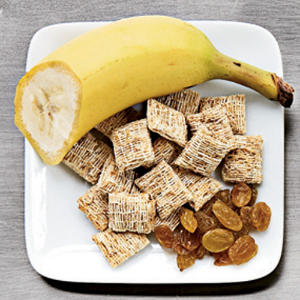Fit With Fiber

Most of us know fiber is good in some vague way. However, when it comes to upping the fiber content of our diets, the thoughts of bran, prunes, and Metamucil leave us procrastinating (and thinking of our grandmothers). The potential advantages of a diet high in fiber are too impressive to be ignored–fiber is no longer something which benefits only the senior crowd. Here is the rundown on what fiber is, its benefits, and how to make it a firm part of your diet.
What is fiber?
Dietary fiber, also known as roughage or bulk, includes all parts of plant foods that your body cannot digest or absorb. It passes relatively intact through your stomach, small intestine, colon, and out of your body. There are two main categories of fiber: insoluble and soluble. Insoluble fiber does not dissolve in water, and it promotes the movement of material through your digestive system. Whole-wheat and bran, nuts, and many vegetables are good sources of this kind of fiber. Soluble fiber dissolves in water to form a gel-like material. It can help lower blood cholesterol and glucose levels, and is found in oats, peas, beans, carrots, citrus fruits, and apples.
The potential benefits:
Aside from the advantages your grandmother probably made you well aware of, the scope of fiber’s benefits extends well beyond gastrointestinal health. Soluble fiber may help lower total blood cholesterol levels by lowering LDL (“bad”) cholesterol levels. Also, studies have shown that an increased consumption of fiber can reduce blood pressure and inflammation, leading to an overall improvement in heart health. Additionally, fiber can work to control blood sugar levels by slowing the absorption of sugar. Diets high in insoluble fiber have been associated with a reduced risk of developing type 2 diabetes.
Fiber has proven to aid in weight loss. Researchers at Brigham Young University in Utah found that increasing fiber intake by 8 grams per 1,000 calories resulted in an average of 4 ½ pounds of weight lost over the course of the study. This held true for all participants, whether their starting fiber intake was 3 grams or 25 grams. High-fiber foods generally require more chewing time; providing your body the time it needs to relay feelings of hunger and fullness cuts back on overeating. Additionally, high-fiber meals tend to be less calorie-dense, yet feel larger and linger longer.
Increasing your intake:
The National Academy of Sciences’ Institute of Medicine, gives the following daily recommendations for adults: 38 g for men 50 and younger; 30 g for men 51 and older; 25 g for women 50 and younger, 21 g for women 51 and older. Those recommendations may sound a bit onerous, but you do not have to resort to eating cardboard to make quota.
The best way increase the amount of fiber in your diet is to do so gradually, over a period of a few weeks. Adding too much fiber too quickly can create intestinal gas, abdominal bloating and cramping. Pacing the addition of fiber to your diet allows the natural bacteria in your digestive system to adjust to the change, and prevents these discomforts from occurring.
Great sources of fiber include grains and whole-grain products, fruits and vegetables, beans, peas, and other legumes, and nuts and seeds. Eating foods in their natural state (or as close to it as possible) ensures that you are maximizing your fiber intake, as many grain refining processes and peeling removes a lot of the fiber content.
If you are looking to increase your fiber intake but already choose whole-grain products and eat plenty of fruits, vegetables, and beans, there are quite few options that are more fiber-loaded than others. Legumes are the real powerhouse when it comes to fiber. Lentils, black beans, pinto beans, white beans, and kidney beans all boast 15 g of fiber or more per cup. Raspberries rule the fibrous fruits with 8 g per cup, with pears and apples also providing solid options. Artichokes, peas, and broccoli are your best vegetable choices.
Beyond choosing the right foods, there are a couple ways to go about making fiber a stronger presence in your diet. Start your day strong with oatmeal or bran, and fruit, or add a few spoonfuls of unprocessed wheat-bran to your cereal or smoothie. Consider a piece of fruit with every meal, and avoid peeling those that do not require it. Bulk up sauces with pre-cut veggies, and thicken soups with puréed beans.







